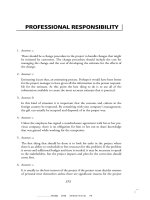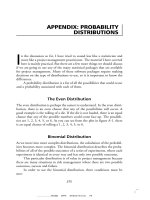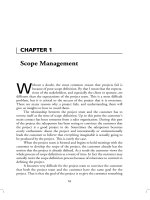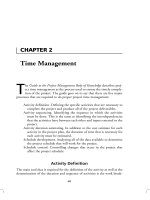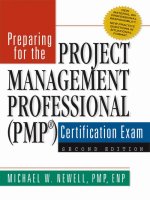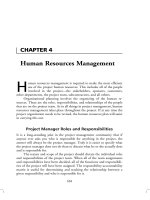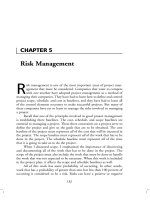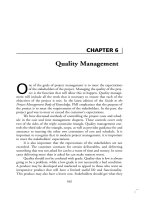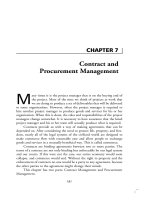project management professional (pmp) study guide by kim heldman
Bạn đang xem bản rút gọn của tài liệu. Xem và tải ngay bản đầy đủ của tài liệu tại đây (8.25 MB, 538 trang )
Using Your Sybex Electronic Book
T
o realize the full potential of this Sybex electronic book, you must have Adobe Acrobat Reader with
Search installed on your computer. To find out if you have the correct version of Acrobat Reader, click on
the Edit menu—Search should be an option within this menu file. If Search is not an option in the Edit
menu, please exit this application and install Adobe Acrobat Reader with Search from this CD (double-
click rp500enu.exe in the Adobe folder).
Navigation
To search, click the Search Query button on the toolbar
or choose Edit >Search > Query to open the Search window. In
the Adobe Acrobat Search dialog’s text field, type the text you
want to find and click Search.
Use the Search Next button (Control+U) and Search
Previous button (Control+Y) to go to other matches in
the book. The Search command also has powerful tools for
limiting and expanding the definition of the term you are
searching for. Refer to Acrobat's online Help (Help > Plug-In
Help > Using Acrobat Search) for more information.
www.sybex.com
Click here to begin using
your Sybex Electronic Book!
Search
Navigate through the book by clicking on the headings that appear in the left panel;
the corresponding page from the book displays in the right panel.
San Francisco • London
PMP
®
:
Project Management
Professional
Study Guide
Kim Heldman
Copyright ©2002 SYBEX, Inc., Alameda, CA
www.sybex.com
Associate Publisher: Neil Edde
Acquisitions and Developmental Editor: Elizabeth Hurley
Editor: Ronn Jost
Production Editor: Kylie Johnston
Technical Editors: Claudia M. Baca, Patti Jansen
Book Designer: Bill Gibson
Graphic Illustrator: Tony Jonick
Electronic Publishing Specialist: Judy Fung
Proofreaders: Dave Nash, Laurie O’Connell, Yariv Rabinovitch, Nancy Riddiough
Indexer: Nancy Guenther
CD Coordinator: Dan Mummert
CD Technician: Kevin Ly
Cover Designer: Archer Design
Cover Illustrator/Photographer: Natural Selection
Copyright © 2002 SYBEX Inc., 1151 Marina Village Parkway, Alameda, CA 94501. World rights reserved. No part of this
publication may be stored in a retrieval system, transmitted, or reproduced in any way, including but not limited to photo-
copy, photograph, magnetic, or other record, without the prior agreement and written permission of the publisher.
Library of Congress Card Number: 2002100063
ISBN: 0-7821-4106-4
SYBEX and the SYBEX logo are either registered trademarks or trademarks of SYBEX Inc. in the United States and/or other
countries.
Screen reproductions produced with FullShot 99. FullShot 99 © 1991-1999 Inbit Incorporated. All rights reserved.
FullShot is a trademark of Inbit Incorporated.
The CD interface was created using Macromedia Director, COPYRIGHT 1994, 1997-1999 Macromedia Inc. For more
information on Macromedia and Macromedia Director, visit .
Internet screen shot(s) using Microsoft Internet Explorer 5.0 reprinted by permission from Microsoft Corporation.
SYBEX is an independent entity from Citrix Systems, Inc., and not affiliated with Citrix Systems, Inc. in any manner. This
publication may be used in assisting students to prepare for a Citrix Certified Administrator Exam. Neither Citrix Systems,
its designated review company, nor SYBEX warrants that use of this publication will ensure passing the relevant exam.
Citrix is either a registered trademark or trademark of Citrix Systems, Inc. in the United States and/or other countries.
TRADEMARKS: SYBEX has attempted throughout this book to distinguish proprietary trademarks from descriptive terms
by following the capitalization style used by the manufacturer.
The author and publisher have made their best efforts to prepare this book, and the content is based upon final release soft-
ware whenever possible. Portions of the manuscript may be based upon pre-release versions supplied by software manu-
facturer(s). The author and the publisher make no representation or warranties of any kind with regard to the completeness
or accuracy of the contents herein and accept no liability of any kind including but not limited to performance, merchant-
ability, fitness for any particular purpose, or any losses or damages of any kind caused or alleged to be caused directly or
indirectly from this book.
Manufactured in the United States of America
10 9 8 7 6 5 4 3 2 1
Copyright ©2002 SYBEX, Inc., Alameda, CA
www.sybex.com
To Our Valued Readers:
Sybex
®
is excited to be publishing the
PMP: Project Management Professional Study Guide
, the first
of its kind for the increasingly critical business area of project management. The “soft skills” covered
are certainly different from the technical topics one usually finds in Sybex
®
Study Guides, but the rele-
vance of such skills to the world of IT and beyond will be immediately evident to all who peruse this
invaluable book.
Just as the Project Management Institute is committed to establishing measurable standards for certi-
fying project management professionals, Sybex is committed to providing those professionals with the
skills and knowledge needed to meet those standards. Our author and editors have worked hard to
ensure that this
PMP: Project Management Professional Study Guide
is comprehensive, in-depth, and
pedagogically sound. We’re confident that this book will meet and exceed the demanding standards
of the certification marketplace and help you, the PMP exam candidate, succeed in your endeavors.
Good luck in pursuit of your PMP certification!
Neil Edde
Associate Publisher—Certification
Sybex, Inc.
Copyright ©2002 SYBEX, Inc., Alameda, CA
www.sybex.com
Software License Agreement: Terms and Conditions
The media and/or any online materials accompanying this
book that are available now or in the future contain pro-
grams and/or text files (the “Software”) to be used in connec-
tion with the book. SYBEX hereby grants to you a license to
use the Software, subject to the terms that follow. Your pur-
chase, acceptance, or use of the Software will constitute your
acceptance of such terms.
The Software compilation is the property of SYBEX unless oth-
erwise indicated and is protected by copyright to SYBEX or
other copyright owner(s) as indicated in the media files (the
“Owner(s)”). You are hereby granted a single-user license to use
the Software for your personal, noncommercial use only. You
may not reproduce, sell, distribute, publish, circulate, or com-
mercially exploit the Software, or any portion thereof, without
the written consent of SYBEX and the specific copyright
owner(s) of any component software included on this media.
In the event that the Software or components include specific
license requirements or end-user agreements, statements of
condition, disclaimers, limitations or warranties (“End-User
License”), those End-User Licenses supersede the terms and
conditions herein as to that particular Software component.
Your purchase, acceptance, or use of the Software will con-
stitute your acceptance of such End-User Licenses.
By purchase, use or acceptance of the Software you further
agree to comply with all export laws and regulations of the
United States as such laws and regulations may exist from
time to time.
Software Support
Components of the supplemental Software and any offers asso-
ciated with them may be supported by the specific Owner(s) of
that material, but they are not supported by SYBEX. Informa-
tion regarding any available support may be obtained from the
Owner(s) using the information provided in the appropriate
read.me files or listed elsewhere on the media.
Should the manufacturer(s) or other Owner(s) cease to offer
support or decline to honor any offer, SYBEX bears no
responsibility. This notice concerning support for the Soft-
ware is provided for your information only. SYBEX is not
the agent or principal of the Owner(s), and SYBEX is in no
way responsible for providing any support for the Software,
nor is it liable or responsible for any support provided, or
not provided, by the Owner(s).
Warranty
SYBEX warrants the enclosed media to be free of physical
defects for a period of ninety (90) days after purchase. The
Software is not available from SYBEX in any other form or
media than that enclosed herein or posted to www.sybex.com.
If you discover a defect in the media during this warranty
period, you may obtain a replacement of identical format at no
charge by sending the defective media, postage prepaid, with
proof of purchase to:
SYBEX Inc.
Product Support Department
1151 Marina Village Parkway
Alameda, CA 94501
Web:
After the 90-day period, you can obtain replacement media
of identical format by sending us the defective disk, proof of
purchase, and a check or money order for $10, payable to
SYBEX.
Disclaimer
SYBEX makes no warranty or representation, either expressed
or implied, with respect to the Software or its contents, qual-
ity, performance, merchantability, or fitness for a particular
purpose. In no event will SYBEX, its distributors, or dealers be
liable to you or any other party for direct, indirect, special,
incidental, consequential, or other damages arising out of the
use of or inability to use the Software or its contents even if
advised of the possibility of such damage. In the event that the
Software includes an online update feature, SYBEX further
disclaims any obligation to provide this feature for any specific
duration other than the initial posting.
The exclusion of implied warranties is not permitted by some
states. Therefore, the above exclusion may not apply to you.
This warranty provides you with specific legal rights; there
may be other rights that you may have that vary from state to
state. The pricing of the book with the Software by SYBEX
reflects the allocation of risk and limitations on liability con-
tained in this agreement of Terms and Conditions.
Shareware Distribution
This Software may contain various programs that are dis-
tributed as shareware. Copyright laws apply to both share-
ware and ordinary commercial software, and the copyright
Owner(s) retains all rights. If you try a shareware program
and continue using it, you are expected to register it. Indi-
vidual programs differ on details of trial periods, registra-
tion, and payment. Please observe the requirements stated
in appropriate files.
Copy Protection
The Software in whole or in part may or may not be copy-
protected or encrypted. However, in all cases, reselling or
redistributing these files without authorization is expressly
forbidden except as specifically provided for by the Owner(s)
therein.
Copyright ©2002 SYBEX, Inc., Alameda, CA
www.sybex.com
To BB for your ever continuing encouragement and support.
—Kim Heldman
Copyright ©2002 SYBEX, Inc., Alameda, CA
www.sybex.com
Acknowledgments
T
hank you to the terrific team at Sybex for their dedication, encour-
agement, and diligence in producing this book. Thanks especially to Kylie
Johnston, production editor, for answering all my questions. I cannot say
enough good things about my great experiences working with the team at
Sybex. They are all wonderful. And thanks to all the rest of the behind-the-
scenes team including Judy Fung, Tony Jonick, Kevin Ly, Dan Mummert,
Dave Nash, Laurie O’Connell, Yariv Rabinovitch, and Nancy Riddiough.
A very special thank you to Elizabeth Hurley for taking a chance on this
book and for giving me the opportunity to write it. Elizabeth, you’re the best!
Thank you to Ronn Jost for the excellent editing job and for never losing
patience with me when I accidentally changed official titles and terms through-
out the manuscript. He kept me straight and caught anomalies I never would
have seen.
Thanks as well to the technical editors, Claudia Baca and Patti Jansen, for
their sharp eye and good suggestions.
None of this would have been possible without the continued sugges-
tions, support, and encouragement from my best friend in the whole world,
BB. Thanks to Bob and Terri for your prayers—they’re always coveted and
pulled me through when I had doubts. Thanks to Jill and John for your
cheerleading behind the scenes and to mom and dad for giving me the love
of reading. And thanks also to Jason, Leah, Noelle, Amanda, Matt, Kate,
and Juliette for understanding my limited availability and for your encour-
agement and enthusiasm.
Copyright ©2002 SYBEX, Inc., Alameda, CA
www.sybex.com
Introduction
T
his book was designed for anyone thinking of taking the Project Man-
agement Professional (PMP
®
) exam sponsored by the Project Management
Institute (PMI
®
). This certification is growing in popularity and demand in all
areas of business. PMI has experienced explosive growth in membership over
the last few years, and more organizations are recognizing the importance of
PMP certification.
This book assumes you have knowledge of general project management
practices, but not necessarily specific
Guide to the Project Management
Body of Knowledge (PMBOK)
practices. It’s written so that you can skim
through areas you are already familiar with, picking up the specific
Guide
to the PMBOK
terminology where needed to pass the exam. Those of you
with no formal training in project management but lots of experience will
find the project management processes and techniques defined in such a
way that you’ll recognize things you’ve always done and be able to identify
them with
Guide to the PMBOK
process names or methodologies.
PMI offers the most recognized certification in the field of project man-
agement, and this book deals exclusively with their procedures and meth-
ods. There are many methods of project management, each with its own
terminology, tools, and procedures. If you are familiar with another organ-
ized project management methodology, don’t assume you already know
the
Guide to the PMBOK
processes. I strongly recommend you learn all
of the processes—their key inputs, tools and techniques, and outputs. Take
time to memorize the Key Terms found at the end of every chapter as well.
Sometimes just understanding the definition of a term will help you answer
a question. It might be that you’ve always done that particular thing or
used the methodology described but called it by another name. Know the
name of each process and its primary purpose.
An Exam Essentials section appears at the end of every chapter to high-
light the topics you’ll most likely find on the exam and help you focus on the
most important material covered in the chapter so that you’ll have a solid
understanding of those concepts. However, it isn’t possible to predict what
questions will be covered on your particular exam, so be sure to study every-
thing in the chapter.
Like the exam itself, this study guide is organized in terms of process
groups and the natural sequence of events a project goes through in its life
Copyright ©2002 SYBEX, Inc., Alameda, CA
www.sybex.com
xx
Introduction
cycle. By contrast, other study guides organize their material by knowledge
area—human resource management, communications management, and
so on—and it can be confusing when studying for the exam to map the pro-
cesses in each knowledge area to process groups.
Review Questions are provided at the end of every chapter. You can use
these to gauge your understanding of the subject matter before reading the
chapter and to point out the areas where you need to concentrate your study
time. If you can answer at least 80 percent of the Review Questions, you can
probably feel comfortable moving on to the next chapter. If you can’t answer
that many correctly, reread the chapter, or the section that seems to be giving
you trouble, and try the questions again.
Don’t rely on studying the Review Questions exclusively as your study
method. The questions you’ll see on the exam will be different than the
questions presented in the book. There are 200 randomly generated ques-
tions on the PMP exam, so it isn’t possible to cover every potential exam
question in the Review Questions section of each chapter. Make sure you
understand the concepts behind the material presented in each chapter and
memorize all the formulas as well.
What Is the PMP Certification?
PMI was founded in 1969 and first started offering the Project Management
Professional certification exam in 1984. They are accredited as an American
National Standards Institute (ANSI) standards developer and also have the
distinction of being the first organization to have their certification program
attain International Organization for Standardization (ISO) 9001 recognition.
PMI boasts a worldwide membership of 86,000, with members from 125
different countries. Local PMI chapters meet regularly and allow project man-
agers to exchange information and learn about new tools and techniques of
project management or new ways to use established techniques. I encourage
you to join a local chapter and get to know other professionals in your field.
PMI is the leader in project management practices and is the most widely
recognized organization and certification in the field. PMI strives to main-
tain and promote standards and ethics in this field and offers publications,
training, seminars, chapters, special interest groups, and colleges to further
the project management discipline.
Copyright ©2002 SYBEX, Inc., Alameda, CA
www.sybex.com
Introduction
xxi
Why Become PMP Certified?
The following benefits are associated with becoming PMP certified:
It demonstrates proof of professional achievement.
It increases your marketability.
It provides greater opportunity for advancement in your field.
It raises customer confidence in you and your company’s services.
Demonstrates Proof of Professional Achievement
PMP certification is a rigorous process that documents your achievements in
the field of project management. The exam tests your knowledge of the dis-
ciplined approaches, methodologies, and project management practices as
described in the
Guide to the PMBOK
published by the Project Management
Institute.
You are required to have several years of experience in project manage-
ment before sitting for the exam, as well as 35 hours of formal project man-
agement education. Your certification assures employers and customers that
you are well grounded in project management practices and disciplines. It
shows that you’ve got the hands-on experience, as well as a mastery of the
processes and disciplines, to manage projects effectively and motivate teams
to produce successful results.
Increases Your Marketability
Many industries are realizing the importance of project management and its
role in the organization. They are also seeing that simply proclaiming a head
technician to be “project manager” does not make it so. Project management,
just like engineering, information technology, and a host of other trades, has
its own specific qualifications and skills. Certification tells potential employers
you’ve got the skills, experience, and knowledge to drive successful projects
and ultimately improve the company’s bottom line.
Certification will always make you stand out over the competition. If you
are certified and are competing against a project manager without certifica-
tion, chances are you will come out as the top pick. As a hiring manager, all
things being equal, I will always opt for the candidate who has certification
over the candidate who doesn’t have it. Certification tells potential employ-
ers you have gone the extra mile. You’ve spent time studying techniques and
methods as well as employing them in practice. It shows dedication to your
Copyright ©2002 SYBEX, Inc., Alameda, CA
www.sybex.com
xxii
Introduction
own professional growth and enhancement, and to adhering to and advanc-
ing professional standards.
Provides Opportunity for Advancement
PMP certification displays your willingness to pursue growth in your pro-
fessional career and shows that you’re not afraid of a little hard work to get
what you want. Potential employers will interpret your pursuit of this cer-
tification as a high-energy, success-driven, can-do attitude on your part.
They will see that you’re likely to display these same characteristics on the
job, which will help make the company successful. Your certification dis-
plays a success-oriented, motivated attitude that will open up opportuni-
ties for future career advancements in your current field as well as new
areas you might want to explore.
Raises Customer Confidence
Just as the PMP certification assures employers that you’ve got the back-
ground and experience to handle project management, customers are also
assured they have a competent, experienced project manager at the helm.
Certification will help your organization sell customers on your abilities to
manage their projects. Customers, like potential employers, want the reas-
surance that those working for them have the knowledge and skills necessary
to carry out the duties of the position and that professionalism and personal
integrity are of utmost importance. Individuals who hold these ideals will
translate their ethics and professionalism to their work. This enhances the
trust customers will have in you, which in turn will give you the ability to
influence them on important project issues.
How to Become PMP Certified
There are several requirements you’ll need to fulfill in order to sit for the
PMP exam. PMI has detailed the certification process quite extensively at
their website. Go to
www.pmi.org
and click the Certification tab to get the
latest information on certification procedures and requirements.
As of the date of this publication, you are required to fill out an appli-
cation to sit for the PMP exam. You can submit this application online at
. You will also need to document 35
hours of formal project management education. This might include college
classes, seminars, workshops, or training sessions. Be prepared to list the
class titles, location, date, and content.
Copyright ©2002 SYBEX, Inc., Alameda, CA
www.sybex.com
Introduction
xxiii
In addition to filling out the application and documenting your formal
project management training, there is one additional set of criteria you’ll need
to meet to sit for the exam. These criteria fall into two categories. You need to
meet the requirements for only one of these categories.
Category 1 is for those who hold a baccalaureate degree. You’ll need
to provide proof, via transcripts, of your degree with your application.
In addition, you’ll need to complete verification forms, found at the
PMI website, that show 4500 hours of project management experi-
ence that spans a minimum of three years and no more than six years.
Category 2 is for those who do not hold a baccalaureate degree but do
hold a high-school diploma or equivalent. You will need to complete
verification forms documenting 7500 hours of project management
experience that spans a minimum of five years and no more than eight
years.
The exam fee at the time of this publication is $405 for PMI members and
$555 for non-PMI members. Testing is conducted at Prometric centers. You
can find a center near you at the PMI website. You have six months from the
time PMI receives and approves your completed application to take the exam.
You’ll need to bring a form of identification such as a driver’s license with you
to the Prometric center on the test day. You will not be allowed to take any-
thing with you into the testing center. You will be given a calculator, pencils,
and scrap paper by the center. You will turn in all scrap paper, including the
notes and squiggles you’ve jotted during the test, to the center upon comple-
tion of the exam.
The exam is scored immediately, so you will know if you’ve passed at the
conclusion of the test. You’re given four hours to complete the exam, which
consists of 200 randomly generated questions that cover the following pro-
cess groups and areas: Initiation, Planning, Executing, Controlling, Closing,
and Professional Responsibility. All unanswered questions are scored as
wrong answers, so it benefits you to guess at an answer if you are stumped
on a question.
After you’ve received your certification, you’ll be required to earn 60 pro-
fessional development units (PDUs) every three years to maintain certifica-
tion. Approximately one hour of structured learning translates to one PDU.
The PMI website details what activities constitute a PDU, how many PDUs
each activity earns, and how to register your PDUs with PMI to maintain
your certification. As an example, attendance at a local chapter meeting
earns one PDU.
Copyright ©2002 SYBEX, Inc., Alameda, CA
www.sybex.com
xxiv
Introduction
Who Should Buy This Book?
If you are serious about passing the PMP exam, you should buy this book
and use it to study for the exam. This book is unique in that it walks you
through the project processes from beginning to end, just as projects are per-
formed in practice. You will benefit from reading this book by learning spe-
cific
Guide to the PMBOK
processes and techniques coupled with real-life
scenarios that describe how project managers in different situations handle
problems and the various issues all project managers are bound to encounter
during their career. This study guide describes in detail the exam objective
topics in each chapter and has attempted to cover all of the important project
management concepts.
How to Use This Book and CD
We’ve included several testing features both in the book and on the compan-
ion CD-ROM. Following this Introduction is an Assessment Test that you
can use to check your readiness for the actual exam. Take this test before you
start reading the book. It will help you determine the areas you may need to
brush up on. The answers to the Assessment Test appear after the last ques-
tion of the test. Each answer includes an explanation and a note telling you
in which chapter this material appears.
As mentioned, to test your knowledge as you progress through the book,
there are Review Questions at the end of each chapter. As you finish each
chapter, answer the Review Questions and then check to see if your answers
are right—the correct answers appear on the pages following the last question.
You can go back to reread the section that deals with each question you got
wrong to ensure that you answer the question correctly the next time you are
tested on the material. You’ll also find 180+ flashcard questions on the CD for
on-the-go review. Download them right onto your Palm device for quick and
convenient reviewing.
In addition to the Assessment Test and the Review Questions, you’ll find
a Practice Exam in the book and a Bonus Exam on the CD. Take these prac-
tice exams just as if you were actually taking the exam (i.e., without any ref-
erence material). When you have finished the first exam, move on to the next
exam to solidify your test-taking skills. If you get more than 90 percent of the
answers correct, you’re ready to go ahead and take the real exam.
Copyright ©2002 SYBEX, Inc., Alameda, CA
www.sybex.com
Introduction
xxv
Additionally, if you are going to travel but still need to study for the PMP
exam, and you have a laptop with a CD-ROM drive, you can take this entire
book with you just by taking the CD. This book is in PDF (Adobe Acrobat)
format so it can be easily read on any computer.
The Exam Objectives
Behind every certification exam, you can be sure to find exam objectives—
the broad topics in which the exam developers want to ensure your compe-
tency. The official PMP exam objectives are listed here.
Exam objectives are subject to change at any time without prior notice and
at PMI’s sole discretion. Please visit the Certification page of PMI’s website,
www.pmi.org
, for the most current listing of exam objectives.
Domain 1.0: Initiation
The objectives for this domain are as follows:
1.
Determine Project Goals.
2.
Determine Deliverables.
3.
Determine Process Outputs.
4.
Document Project Constraints.
5.
Document Project Assumptions.
6.
Define Strategy.
7.
Identify Performance Criteria.
8.
Determine Resource Requirements.
9.
Define Budget.
10.
Produce Formal Documentation.
Copyright ©2002 SYBEX, Inc., Alameda, CA
www.sybex.com
xxvi
Introduction
Domain 2.0: Planning
The objectives for this domain are as follows:
1.
Refine Project.
2.
Create WBS.
3.
Develop Resource Management Plan.
4.
Refine Time and Cost Estimates.
5.
Establish Project Controls.
6.
Develop Project Plan.
7.
Obtain Plan Approval.
Domain 3.0: Execution
The objectives for this domain are as follows:
1.
Commit Resources.
2.
Implement Resources.
3.
Manage Progress.
4.
Communicate Progress.
5.
Implement Quality Assurance Procedures.
Domain 4.0: Control
The objectives for this domain are as follows:
1.
Measure Performance.
2.
Refine Control Limits.
3.
Take Corrective Action.
4.
Evaluate Effectiveness of Corrective Action.
5.
Ensure Plan Compliance.
6.
Reassess Control Plans.
7.
Respond to Risk Event Triggers.
8.
Monitor Project Activity.
Copyright ©2002 SYBEX, Inc., Alameda, CA
www.sybex.com
Introduction
xxvii
Domain 5.0: Closing
The objectives for this domain are as follows:
1.
Obtain Acceptance of Deliverables.
2.
Document Lessons Learned.
3.
Facilitate Closure.
4.
Preserve Product Records and Tools.
5.
Release Resources.
Domain 6.0: Professional Responsibility
The objectives for this domain are as follows:
1.
Ensure Integrity.
2.
Contribute to Knowledge Base.
3.
Apply Professional Knowledge.
4.
Balance Stakeholder Interests.
5.
Respect Differences.
Tips for Taking the PMP Exam
Here are some general tips for taking your exam successfully:
Get to the exam center early so that you can relax and review your
study materials.
Read the exam questions very carefully. Make sure you know exactly
what the question is asking and don’t be tempted to answer too quickly.
Unanswered questions score as wrong answers. It’s better to guess
than leave a question unanswered.
If you’re not sure of an answer, use a process of elimination to identify
the obvious incorrect answers first. Narrow the remaining choices
down by referring back to the question, looking for key words that
might tip off the answer.
Visit the PMI website at
www.pmi.org
for the latest information
regarding certification and to find a testing site nearest you.
Copyright ©2002 SYBEX, Inc., Alameda, CA
www.sybex.com
Assessment Test
1.
Which performance measurement tells us how much more of the bud-
get is required to finish the project?
A.
ETC
B.
EV
C.
AC
D.
EAC
2.
Which of the following compression techniques increases risk?
A.
Crashing
B.
Resource leveling
C.
Fast tracking
D.
Lead and lag
3. You are a project manager for Waterways Houseboats, Inc. You’ve
been asked to perform a benefit/cost analysis for two proposed projects.
Project A costs $2.4 million with potential benefits of $12 million
and future operating costs of $3 million. Project B costs $2.8 million
with potential benefits of $14 million and future operating costs of
$2 million. Which project should you recommend?
A. Project A because the cost to implement is cheaper than Project B
B. Project A because the potential benefits plus the future operating
costs are less in value than the same calculation for Project B
C. Project B because the potential benefits minus the implementation
and future operating costs are greater in value than the same cal-
culation for Project A
D. Project B because the potential benefits minus the costs to imple-
ment are greater in value than the same calculation for Project A
Copyright ©2002 SYBEX, Inc., Alameda, CA
www.sybex.com
Assessment Test xxix
4. These diagrams rank order factors for corrective action by frequency
of occurrence. They are also a type of histogram:
A. Control charts
B. Process flowcharts
C. Scatter diagrams
D. Pareto diagrams
5. You’ve been assigned as a project manager on a research and devel-
opment project for a new dental procedure. You’ve published the
scope statement and are working on the scope management plan.
What is the purpose of the scope management plan?
A. It describes and documents a scope baseline to help make future
project decisions.
B. It decomposes project deliverables.
C. It describes how project scope changes will be incorporated into
the project and how project scope will be managed.
D. It describes how cost and time estimates can be composed for
project scope changes.
6. What is one of the most important skills a project manager can have?
A. Negotiation skills
B. Influencing skills
C. Communication skills
D. Problem-solving skills
7. The project manager has the greatest influence over quality during
which process?
A. Quality Planning
B. Quality Assurance
C. Quality Control
D. Quality Change Control
Copyright ©2002 SYBEX, Inc., Alameda, CA
www.sybex.com
xxx Assessment Test
8. Project managers have the highest level of authority and the most
power in which type of organizational structure?
A. Projectized
B. Strong matrix
C. Functional
D. Balanced matrix
9. You are the project manager for Heartthrobs by the Numbers Dating
Services. You’re working on an updated Internet site that will display
pictures as well as short bios of prospective heartbreakers. You have
your activity list and resource requirements in hand and are planning
on using qualitatively based durations and reserve time to determine
activity durations. Which of the following is true?
A. You are using inputs of the Activity Duration Estimating process.
B. You are using tools and techniques of the Cost Estimating process.
C. You are using tools and techniques of the Activity Duration Esti-
mating process.
D. You are using inputs of the Cost Estimating process.
10. You are a project manager who has recently held a project team kick-
off meeting where all the team members were formally introduced to
each other. Some of the team members know each other from other
projects and have been working with you for the past 3 weeks during
the Planning processes. Which of the following is true?
A. Team building begins once all the members of the team are identi-
fied and introduced to each other. This team is in the storming
stage of Team Development.
B. Team building begins at the Planning process. This team is in the
storming stage of Team Development.
C. Team building begins once all the members of the team are identi-
fied and introduced to each other. This team is in the forming stage
of Team Development.
D. Team building begins at the Planning process. This team is in the
forming stage of Team Development.
Copyright ©2002 SYBEX, Inc., Alameda, CA
www.sybex.com
Assessment Test xxxi
11. Project managers spend what percentage of their time communicating?
A. 90
B. 85
C. 75
D. 50
12. All of the following are true regarding configuration management
except:
A. Requires all acceptance decisions to be made through the CCB
B. Serves as a change control system
C. Describes the physical characteristics of the product of the project
D. Controls changes to the characteristics of an item
13. Which of the following project-scheduling techniques allows for con-
ditional and probabilistic treatment?
A. GERT
B. CPM
C. PERT
D. CPM and PERT
14. Which of the following contracts should you use for projects that have
a degree of uncertainty and require a large investment early in the
project life cycle?
A. Fixed price
B. Cost reimbursable
C. Lump sum
D. Unit price
Copyright ©2002 SYBEX, Inc., Alameda, CA
www.sybex.com
xxxii Assessment Test
15. You are the project manager for Lucky Stars Candies. You’ve identi-
fied the deliverables and requirements and documented them where?
A. In the scope statement, which will be used as in input to the Scope
Definition process
B. In the scope definition document, which is used as an input to the
Scope Planning process
C. In the WBS, which is an output of the Scope Planning process
D. In the WBS, which is a tool and technique of the Scope Definition
process
16. All of the following are true regarding Ishikawa diagrams in the Qual-
ity Planning process except:
A. They are also called cause-and-effect diagrams.
B. They are also called fishbone diagrams.
C. They are a tool and technique of this process.
D. They are an output of this process.
17. The primary function of the Closing process is to:
A. Formalize lessons learned and distribute this information to
project participants
B. Perform audits to verify the project results against the project
requirements
C. Formalize project completion and disseminate this information to
project participants
D. Perform post-implementation audits to document project successes
and failures
Copyright ©2002 SYBEX, Inc., Alameda, CA
www.sybex.com
Assessment Test xxxiii
18. What is the purpose of the project charter?
A. To recognize and acknowledge the project sponsor
B. To recognize and acknowledge the existence of the project and
commit organizational resources to the project
C. To acknowledge the existence of the project team, project man-
ager, and project sponsor
D. To describe the selection methods used to choose this project over
its competitors
19. Which performance measurement tells us what the projected total cost
of the project will be at completion?
A. ETC
B. CPI
C. SPI
D. EAC
20. People are motivated by the need for achievement, power, or affilia-
tion according to which theory?
A. Expectancy theory
B. Achievement theory
C. Contingency theory
D. Theory X
21. You are a project manager working in a foreign country. You observe
that some of your project team members are having a difficult time
adjusting to the new culture. You provided them training on cultural
differences and the customs of this country before arriving, but they
still seem uncomfortable and disoriented. Which of the following
is true?
Copyright ©2002 SYBEX, Inc., Alameda, CA
www.sybex.com
xxxiv Assessment Test
A. This is the result of working with teams of people from two differ-
ent countries.
B. This condition is known as culture shock.
C. This is the result of jet lag and travel fatigue.
D. This condition is known as global culturalism.
22. The Project Management Knowledge Areas:
A. Include Initiation, Planning, Executing, Controlling, and Closing
B. Consist of nine different areas that bring together processes that
have things in common
C. Consist of five different processes that bring together phases of
projects that have things in common
D. Include Planning, Executing, and Controlling processes as these
three processes are commonly interlinked
23. You are the project manager for a construction company that is build-
ing a new city and county office building in your city. You recently
looked over the construction site to determine if the work to date was
conforming to the requirements and quality standards. Which tool
and technique of Quality Control are you using?
A. Performance measurements
B. Inspection
C. Sampling
D. Prevention
24. Which of the following is true regarding Administrative Closure?
A. It occurs at the end of a project phase and at the end of the project.
B. It occurs at the end of the project phase only.
C. It occurs at the end of the project only.
D. It is performed prior to Contract Closeout.
Copyright ©2002 SYBEX, Inc., Alameda, CA
www.sybex.com
Assessment Test xxxv
25. You are the project manager for Heart of Texas casual clothing com-
pany. Your project involves installing a new human resources system.
You’ve identified the risks associated with this project and are ready
for the next step. What is the next step?
A. You will evaluate the risks and assign probabilities and impacts
using Qualitative and/or Quantitative Risk Analysis.
B. You will use the Delphi technique to confirm the risks you’ve
detailed and identify others you may have missed.
C. You must evaluate the risks and assign probabilities and impacts
using both Qualitative Risk Analysis, which comes first, then
Quantitative Risk Analysis.
D. You will define the steps to take to respond to the risks and detail
them in the risk response plan.
26. The project sponsor has approached you with a dilemma. The CEO
announced at the annual stockholders meeting that the project you’re
managing will be completed by the end of this year. The problem is that
this is six months prior to the scheduled completion date. It’s too late to
go back and correct her mistake, and stockholders are expecting imple-
mentation by the announced date. You must speed up the delivery date
of this project. Your primary constraint before this occurred was the
budget. What actions can you take to help speed up the project?
A. Hire more resources to get the work completed faster.
B. Ask for more money so that you can contract out one of the phases
you had planned to do with in-house resources.
C. Utilize negotiation and influencing skills to convince the project
sponsor to speak with the CEO and make a correction to her
announcement.
D. Examine the project plan to see if there are any phases that can be
fast tracked, and then revise the project plan to reflect the com-
pression of the schedule.
Copyright ©2002 SYBEX, Inc., Alameda, CA
www.sybex.com
xxxvi Assessment Test
27. During your project meeting, a problem was discussed and a resolu-
tion to the problem was reached. During the meeting, the participants
started wondering why they thought the problem was such a big issue.
Sometime after the meeting, you received an e-mail from one of the
meeting members saying they’ve changed their mind about the solu-
tion reached in the meeting and need to resurface the problem. The
solution reached during the initial project meeting is an example of
which of the following conflict resolution techniques?
A. Confrontation
B. Forcing
C. Smoothing
D. Storming
28. You are the project manager for Heartthrobs by the Numbers Dating
Services. You’re working on an updated Internet site that will display
pictures as well as short bios of prospective heartbreakers. You’ve just
completed your project staff assignments and published the project
team directory. Which process are you in?
A. Resource Planning
B. Organizational Planning
C. Project Development Planning
D. Staff Acquisition
29. Which of the following describes the Executing process?
A. Project plans are put into action.
B. Project performance measurements are taken and analyzed.
C. Project plans are developed.
D. Project plans are published.
Copyright ©2002 SYBEX, Inc., Alameda, CA
www.sybex.com
